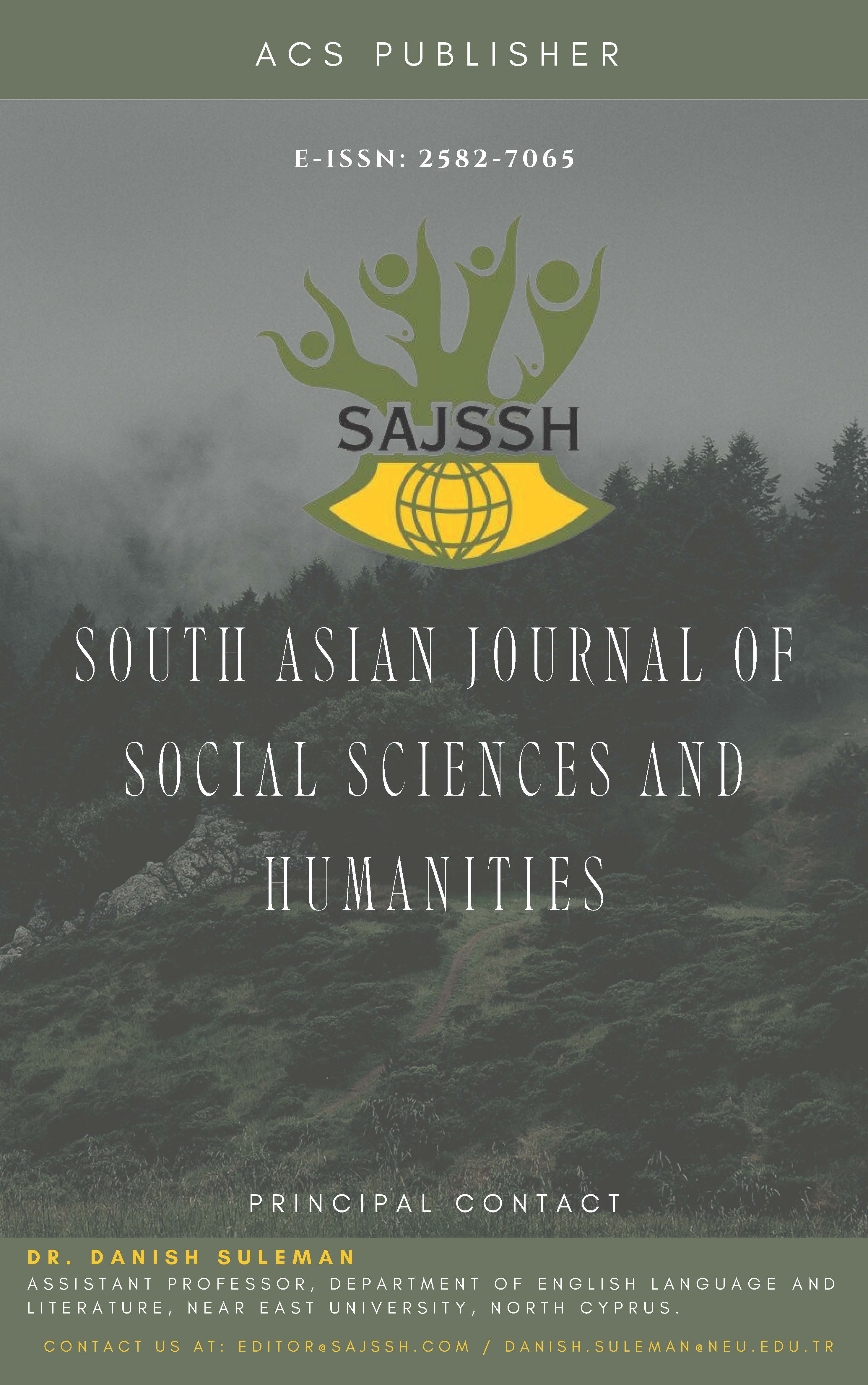Framing Development And Resistance: A Content Analysis Of Media Narratives On The Siang Upper Multipurpose Dam
DOI:
https://doi.org/10.48165/sajssh.2024.6505Keywords:
Media Framing, Hydropower Development, Indigenous Resistance, Environmental Communication, Northeast IndiaAbstract
This study conducts a qualitative content analysis of news articles from The Hindu and The Arunachal Times, examining how media frame the proposed Siang Upper Multipurpose Project (SUMP) in Arunachal Pradesh. The analysis reveals that The Hindu predominantly frames the dam in terms of national policy, developmental progress, and strategic considerations, whereas The Arunachal Times focuses on indigenous rights, cultural and ecological concerns, and procedural issues such as the absence of Free, Prior, and Informed Consent (FPIC). The Hindu's coverage tends to highlight institutional perspectives and national interest narratives, while The Arunachal Times amplifies grassroots opposition and local perspectives. These divergent framings illustrate the media's dual role in both legitimizing state-led development narratives and empowering indigenous resistance. The study contributes to understanding how media narratives shape public discourse on controversial infrastructure projects, highlighting implications for environmental communication and the representation of marginalized voices.
References
Baruah, S. (2020). In the Name of the Nation: India and Its Northeast. Stanford University Press.
Baviskar, A. (1995). In the Belly of the River: Tribal Conflicts over Development in the Narmada Valley. Oxford University Press.
Bhuyan, A. (2015). Northeast in the national media: Neglect and marginalization. Economic and Political Weekly, 50(49), 10–13.
Cappella, J. N., & Jamieson, K. H. (1997). Spiral of Cynicism: The Press and the Public Good. Oxford University Press.
Cox, R. (2013). Environmental Communication and the Public Sphere (3rd ed.). Sage Publications.
Dandekar, P., & Thakkar, H. (2010). Dams, Displacement, Policy and Law in India. South Asia Network on Dams, Rivers and People.
Degu Belay, Y., Fantini, E., & Gagliardone, I. (2021). The Grand Ethiopian Renaissance Dam: Media narratives and state building. Contemporary Rupture Ethiopia, 2, 28–49.
Deka, A., Hazarika, N., Vij, S., Barua, A., & Fantini, E. (2023). Media reporting on conflicts and cooperation: What does it mean for the Brahmaputra Basin? International Journal of Water Resources Development, 39(5), 819–845. https://doi.org/10.1080/07900627.2022.2163478
Delang, C. (2019). Media discourses of Mekong dams: A thematic analysis. Problemy Ekorozwoju – Problems of Sustainable Development, 14(1), 119–130.
Entman, R. M. (1989). How the media affect what people think: An information processing approach. The Journal of Politics, 51(2), 347–370. https://doi.org/10.2307/2131346
Entman, R. M. (1993). Framing: Toward clarification of a fractured paradigm. Journal of Communication, 43(4), 51–58. https://doi.org/10.1111/j.1460-2466.1993.tb01304.x
Entman, R. M. (2007). Framing bias: Media in the distribution of power. Journal of Communication, 57(1), 163–173. https://doi.org/10.1111/j.1460-2466.2006.00336.x
Escobar, A. (1995). Encountering Development: The Making and Unmaking of the Third World. Princeton University Press.
Fernandes, W. (2008). Development-induced displacement: The class and gender perspective. Social Change, 38(4), 580–602.
Fürsich, E. (2010). Media and the representation of others. International Social Science Journal, 61(199), 113–130. https://doi.org/10.1111/j.1468-2451.2010.01751.x
Ghosh, T. (2012). Lower Subansiri Dam and Power Station in Arunachal Pradesh, Northeast India. In A. J. Das (Ed.), Reporting Dams and Development: Strengthening Media’s Capacity to Report Research in Northeast India (Case study). Panos South Asia & Panos London.
Gitlin, T. (1980). The Whole World Is Watching: Mass Media in the Making and Unmaking of the New Left. University of California Press.
Goffman, E. (1974). Frame Analysis: An Essay on the Organization of Experience. Harvard University Press.
Goswami, U. (2014). Hydropower development in Arunachal Pradesh: A review of the ecological and social impacts. International Journal of Environmental Studies, 71(5), 639–655.
Guo, L., Wei, J., Zhang, K., Wang, J., & Tian, F. (2022). Building a methodological framework for media dataset tracking of conflict and cooperation dynamics on transboundary rivers. Hydrology and Earth System Sciences, 26, 1165–1185. https://doi.org/10.5194/hess-26-1165-2022
Jeffrey, R. (2000). India’s Newspaper Revolution: Capitalism, Politics and the Indian Language Press. Oxford University Press.
Matthes, J., & Kohring, M. (2008). The content analysis of media frames: Toward improving reliability and validity. Journal of Communication, 58(2), 258–279. https://doi.org/10.1111/j.1460-2466.2008.00384.x
Mawdsley, E. (2004). India’s middle classes and the environment. Development and Change, 35(1), 79–103. https://doi.org/10.1111/j.1467-7660.2004.00343.x
Melkote, S. R. (1991). Communication for Development in the Third World: Theory and Practice for Empowerment (2nd ed.). Sage Publications.
Pezzullo, P. C., & Cox, R. (2017). Environmental Communication and the Public Sphere (4th ed.). Sage Publications.
Phadke, A. (2013). Development, displacement, and the ethical dilemmas of the Indian dam debate. Asian Ethics, 19(2), 144–160.
Pittock, J. (2010). Better management of hydropower in the era of climate change. Water Alternatives, 3(2), 444–452.
Reese, S. D. (2007). The framing project: A bridging model for media research revisited. Journal of Communication, 57(1), 148–154. https://doi.org/10.1111/j.1460-2466.2006.00334.x
Sainath, P. (2000). Everybody Loves a Good Drought: Stories from India’s Poorest Districts. Penguin Books.
Scheufele, B. (2004). Framing-effects approach: A theoretical and methodological critique. Communications, 29(4), 401–428. https://doi.org/10.1515/comm.2004.29.4.401
Servaes, J. (1999). Communication for Development: One World, Multiple Cultures. https://doi.org/10.13140/RG.2.1.2113.7120
Semetko, H. A., & Valkenburg, P. M. (2000). Framing European politics: A content analysis of press and television news. Journal of Communication, 50(2), 93–109. https://doi.org/10.1111/j.1460-2466.2000.tb02843.x
Sharma, M. (2014). Development, displacement and resistance: The politics of dams in Northeast India. Journal of Borderlands Studies, 29(3), 353–368.
Taying, M. (2025). Indigenous concerns on dam project over Siang River: A landmark effort to save ancestral lands and rivers and environmental degradation. International Journal of Interdisciplinary Research and Innovations, 13(1), 66–71.
Tully, J. (1995). Strange Multiplicity: Constitutionalism in an Age of Diversity. Cambridge University Press.
Vreese, C. H. (2005). News framing: Theory and typology. Information Design Journal, 13(1), 51–62. https://doi.org/10.1075/idjdd.13.1.06vre
Wang, J., Wei, J., & Tian, F. (2024). Are transboundary water events reported differently in French and English news for conflict and cooperation dynamics? Water, 16(5), Article 759. https://doi.org/10.3390/w16050759
Wei, J., Wei, Y., Tian, F., Nott, N., De Wit, C., & Guo, L. (2021). News media coverage of conflict and cooperation dynamics of water events in the Lancang-Mekong River Basin. Hydrology and Earth System Sciences, 25, 1603–1615. https://doi.org/10.5194/hess-25-1603-2021
Wu, S., Huang, S., Wei, Y., Duffield, C., Tang, W., & Zhao, Y. (2018). A longitudinal analysis of major world newspapers’ perspectives on the Three Gorges Dam Project (1982–2015). Water Supply, 18(1), 94–107. https://doi.org/10.2166/ws.2017.088
Downloads
Published
Issue
Section
License
Copyright (c) 2025 South Asian Journal of Social Sciences and Humanities

This work is licensed under a Creative Commons Attribution 4.0 International License.





